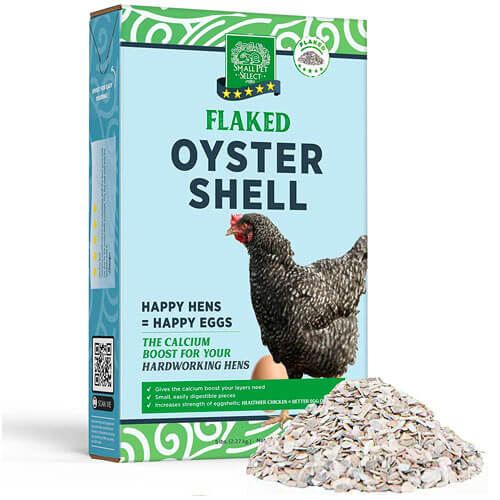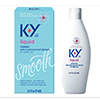Egg Bound Chicken: Symptoms And Treatment (+Vet Advice)
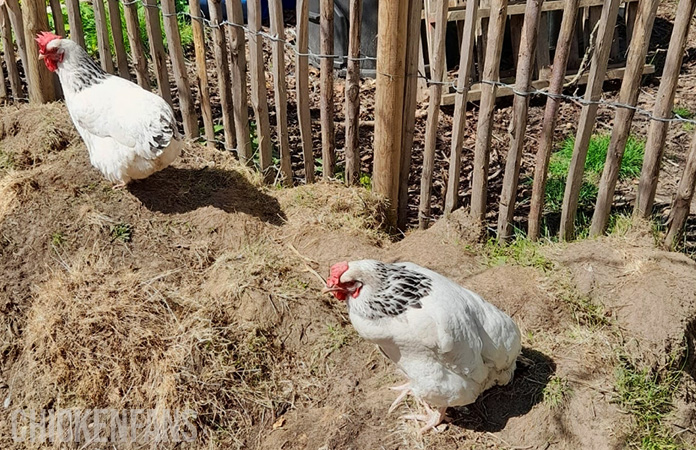

Laying eggs is a natural part of a chicken’s reproductive cycle, but sometimes things can go wrong. A serious and possibly life-threatening situation is commonly called ‘egg binding’, a condition in which an egg becomes stuck inside a chicken’s reproductive tract.
We’ll take a closer look at egg binding in chickens, its causes, symptoms, treatments, and some tips on preventing it from happening in the first place.
What is Egg Binding in Chickens?
Egg binding in chickens is when an egg gets physically stuck inside the oviduct, usually between the shell gland and the cloaca. This is an emergency situation as the chicken can’t pass the egg without help. In this case, the chicken is referred to as egg-bound.
To understand egg binding, you need to have a clear picture of a chicken’s reproductive system. Namely, it consists of two parts:
- Ovaries (unlike mammals, chickens have a single ovary – the left one)
- Oviduct (which includes the uterus or shell gland)
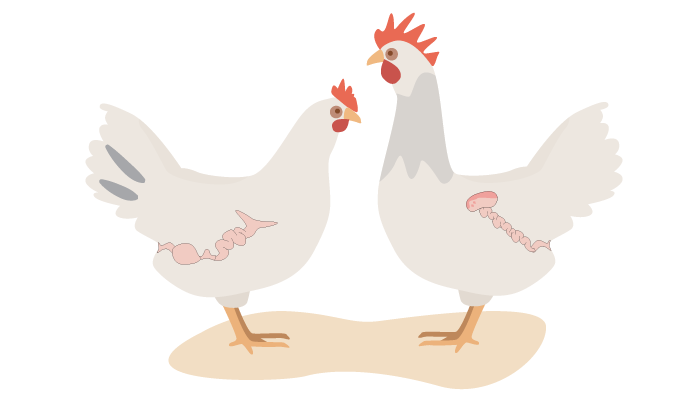
The egg moves through the reproductive tract, with the pointed end leading from the ovary to the shell gland, where the shell is formed around the egg.
During this process, the egg should rotate so the blunt end is first to come out.
The cause of egg binding is the egg’s failure to complete the rotation, resulting in the egg becoming stuck. Simply put, if the egg cannot complete its turning maneuver, it will get stuck in the hen’s reproductive tract.
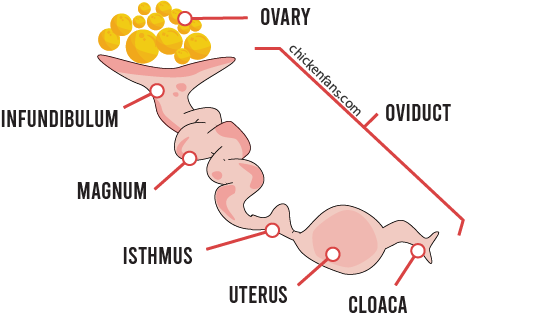
Is Egg Binding in Chickens Dangerous?
Yes, egg binding in chickens is dangerous. Egg bound chickens are at risk of complications such as prolapsed vent, infections, bleeding or oviduct damage. In severe cases, and if left untreated, egg binding can be fatal. Death is possible if the egg is not removed within 48 hours.
First Aid For An Egg-Bound Chicken
Veterinary help is always necessary in egg-bound chickens, but first aid can be helpful in mild cases. It can also help with the symptoms until veterinary aid is available. First aid for egg-bound chickens includes four aspects.
- Calm Environment: Separate the egg-bound chicken from the rest of the flock and place it in a calm, stress-free, and temperature-controlled room.
- Rehydration: Rehydrate the chicken using water or electrolyte solutions. Remember that its natural fluid intake is decreased, meaning you will probably have to use a syringe or dropper. Adding calcium and vitamin D supplements is also recommended.
- Moist heat: Place the chicken in an incubator covered with wet towels or bathe the chicken in lukewarm water for 5 to 10 minutes.
- Lubricate the vent area: Lubricate the chicken’s vent area or cloaca using a lubricant gel.
What Not To Do!
When providing first-aid to an egg-bound chicken, DO NOT:
- Massage the abdomen, as you risk breaking the egg and causing infections
- Use vegetable oils for lubrication as they can quickly go rancid
- Delay veterinary attention, as you have less than 48 hours to remove the egg
Causes of an Egg-Bound Chicken
Several possible causes and factors are contributing to egg binding in chickens. Here is an overview of the most important underlying issues:
- Poor Diet: Metabolically speaking, egg-laying is a demanding process that requires many nutrients, including calcium and protein. Low-quality diets increase the risk of egg binding.
- Obesity: Overweight chickens have weaker muscles that do not contract to the extent necessary for expelling eggs.
- Lack Of Nesting Area: If there is no suitable nesting area, chickens may retain the eggs until one is available, eventually resulting in egg binding. Find out here how many nesting boxes to provide.
- Stress: Stress affects the egg-laying process and may result in retention. Possible stress factors include environmental changes, hot weather, new flock members, etc.
- Premature Laying: Young pullets that are artificially stimulated to lay eggs are prone to egg binding. Their bodies are not fully developed and not ready for egg production.
- Large Or Misshapen Eggs: The risk of egg binding is higher in chickens that produce oversized or malformed eggs.
- Oviduct Infections: Infections affecting the hen’s reproductive tract cause muscle weakness and can result in egg binding.
- Internal Parasites: Chickens with heavy worm loads in the intestines are more likely to become egg-bound.
Are Certain Breeds More Prone To Becoming Egg Bound?
Yes, small chicken breeds such as Bantams are at higher-than-average risk of becoming egg-bound. In addition to being more common, egg binding is also more serious in smaller chicken breeds than bigger chickens.
Symptoms of an Egg Bound Chicken
From “penguin walk” to excessive nesting box sitting behavior to appetite loss – there are several signs and symptoms of egg binding. Let’s take a look at each.
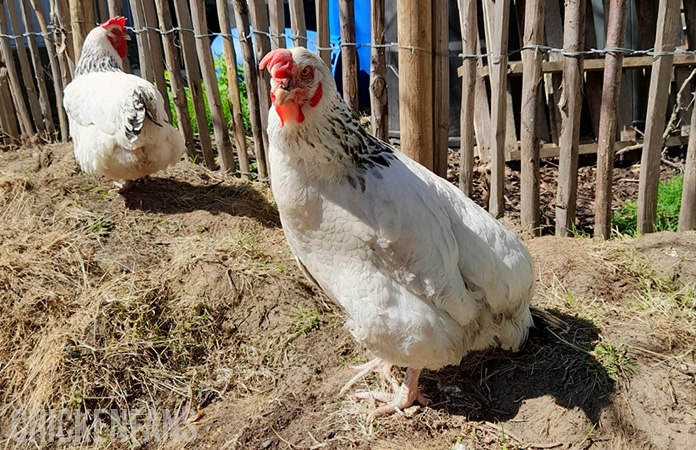
- Penguin Walk: Typical sign of egg-binding is a penguin stand, in which the hen has a wide leg stance and upright positioned body due to the overall discomfort.
- Nestbox Sitting Behavior: The chicken visits the nesting box frequently but cannot produce an egg.
- Tail Pumping: This refers to the hen squatting low to the ground and moving the tail up and down in an attempt to lay the egg.
- Distended Abdomen: The chicken’s abdomen will be significantly larger than usual.
- Lameness: If the retained egg pressures the pelvic nerves, the hen may become lame on one or both legs.
- Loss Of Appetite: Egg-bound chickens have decreased appetite and will drink less.
- Diarrhea: Diarrhea is a common sign because the cloaca is relaxed and cannot form proper feces.
- Constipation: Smaller chickens can be constipated instead of having diarrhea if the egg pressures the intestines.
- Altered Breathing: Heavy breathing (dyspnea) is possible if the retained egg pressures the air sacs.
- Shaking: The constant straining and unsuccessful laying attempts result in exhaustion and shaking.
- Cyanosis: The comb may turn blue-purple due to low oxygen levels caused by breathing issues.
How To Diagnose An Egg-Bound Chicken?
If you suspect egg binding, feel the hen’s abdomen. However, there are two important things to keep in mind when performing abdominal palpation on egg-bound hens:
- You need to be extra careful. If you accidentally break the egg, the chicken can develop egg yolk peritonitis (infection) – the normal bacteria will now have nutrients from the broken egg.
- Poorly calcified eggs are not palpable, meaning the test results can be falsely negative.
To diagnose egg binding, vets use either:
- Radiographs: giving a clear picture of the egg’s location within the oviduct
- Ultrasound: helpful when the egg is shell-less and therefore undetectable on an x-ray image
Treatment For Egg-Bound Chickens
Depending on the severity of the condition and the egg location, there are three treatment options:
- Medication: The vet will rehydrate the chicken with injectable fluids and give calcium and vitamin D. This approach is successful in mild cases.
- Percloacal Ovocentesis: If the egg is close to the cloaca, the vet may use a large-gauge needle to aspirate the egg content and cause the eggshell to collapse. This allows the empty shell to be removed or passed out naturally.
- Surgery: In severe cases, and when the egg is not visible, the vet must surgically remove the egg while the chicken is under general anesthesia.
Regardless of the approach, the vet may recommend antibiotics if they suspect infections. It is advisable to give your chicken probiotics whenever you are using antibiotics.
If your chicken is frequently egg-bound, consider hormonal therapy that will alter the egg production cycle or, in more severe cases, euthanasia.
Preventing Egg Binding In Chickens
Egg binding is not 100% preventable. However, there are several things you can do to decrease the risk. Here are some simple and useful tips for preventing egg binding:
- Provide complete and nutritionally balanced food
- Use high-quality calcium supplements
- Do not give scraps or excess treats that can cause obesity
- Reduce stress to a minimum
- Ensure proper nesting areas for all chickens
- Practice regular deworming
- Avoid supplemental lighting in young pullets
Summary
Although uncommon, egg binding can be a life-threatening condition that requires immediate attention. As a responsible chicken keeper, knowing how to provide basic first aid is important. However, you should also know when it is time to seek veterinary advice.
Finally, practice “walking your flock” several times a day and observe them. By watching your chickens, you will know what normal behavior is and easily spot problems like egg binding.
If you want to learn more about health problems in chickens, check out our ‘Health‘ page.

Dr. I. Crnec is a licensed veterinarian with several years of experience. She has published work on the effect of vitamin supplementation, egg-laying performances of chickens under heat-stress conditions and the effects of calcium supplementation on eggshell strength.

